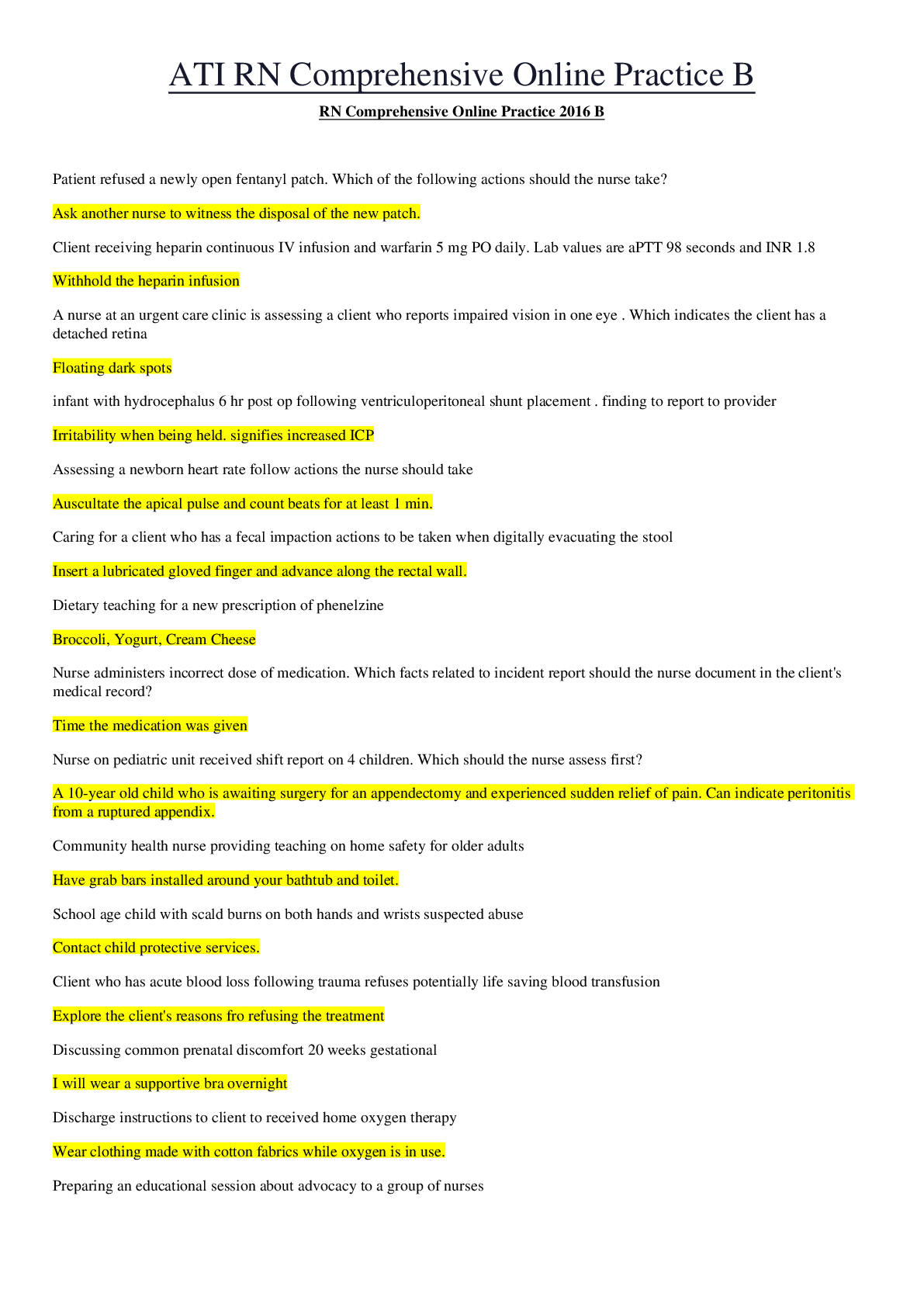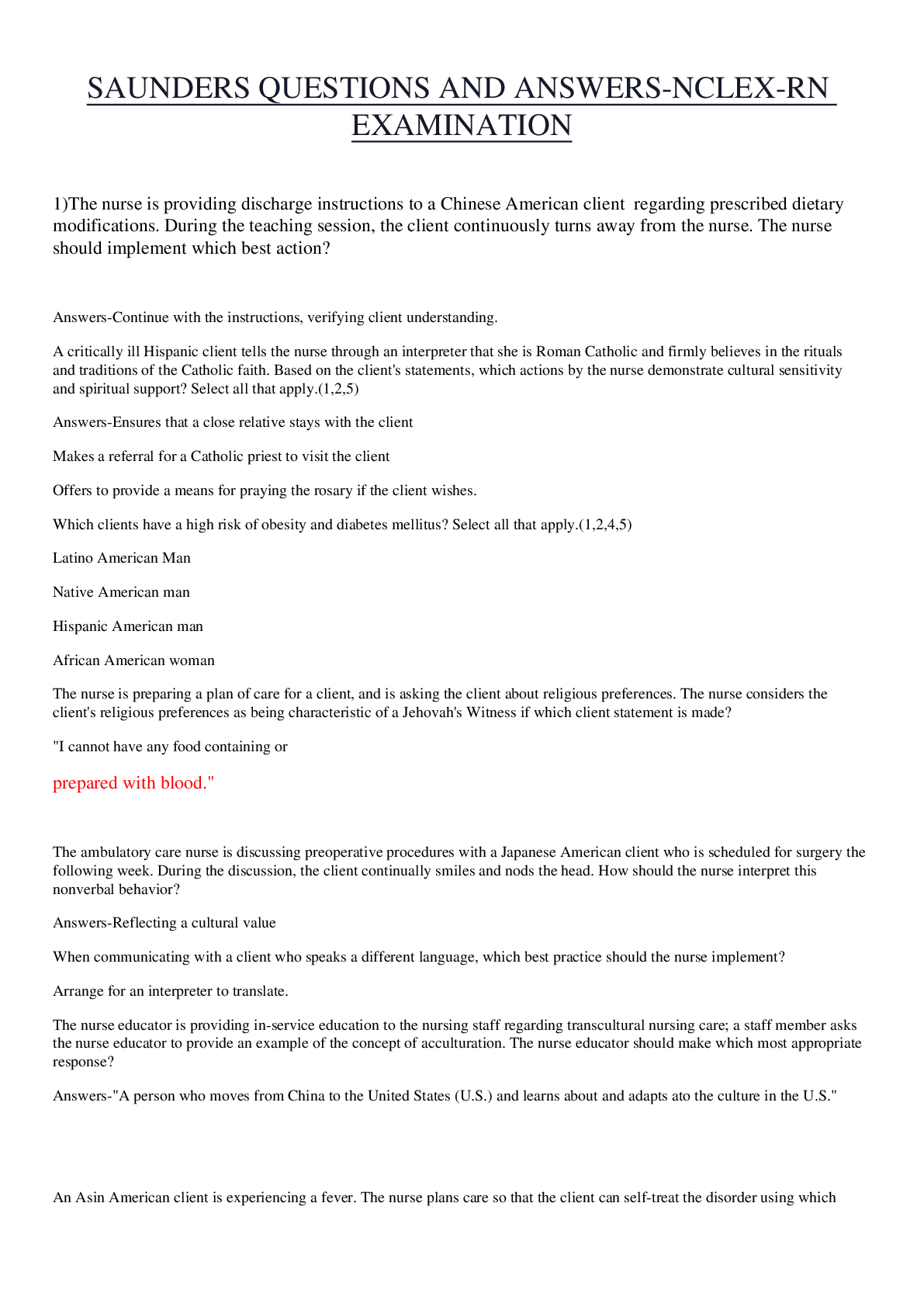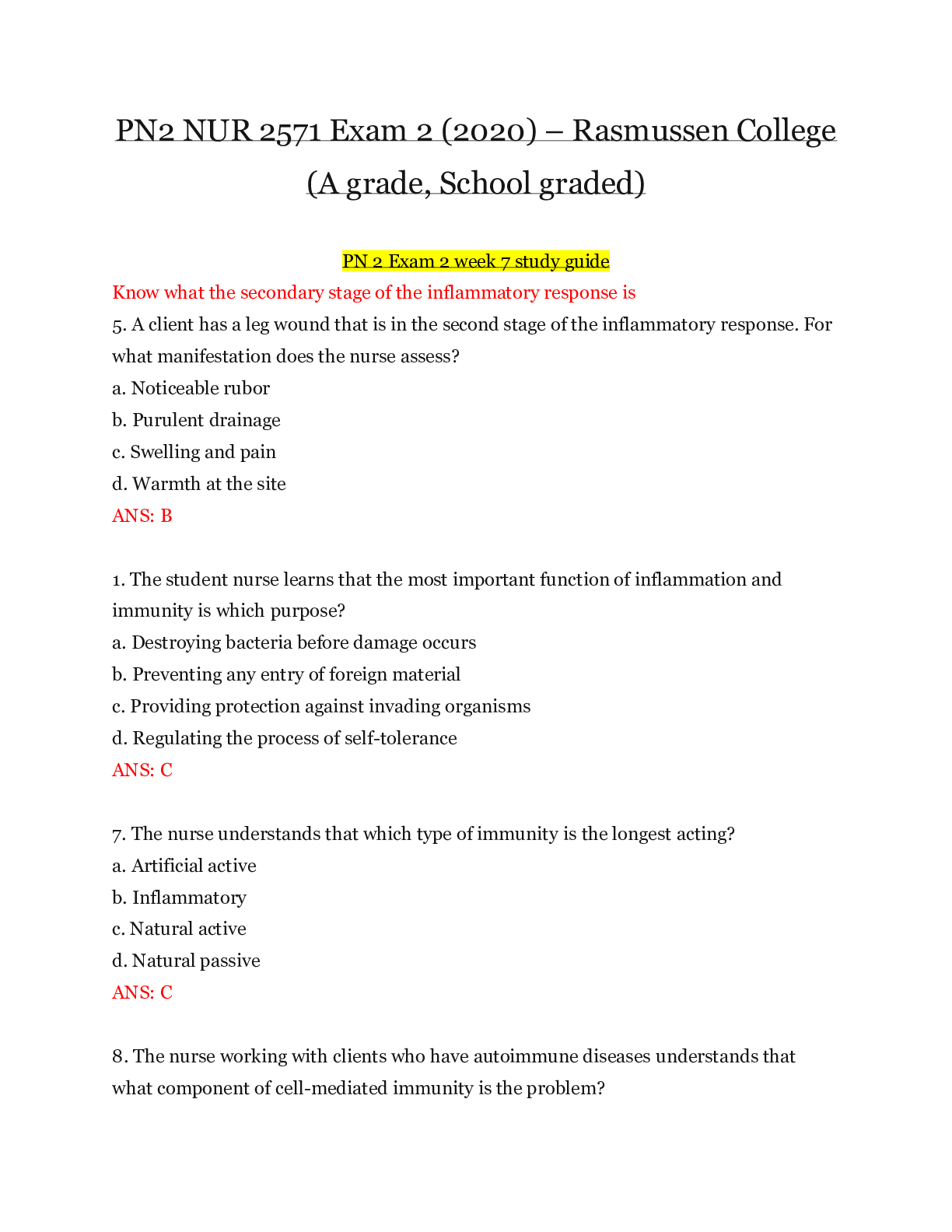*NURSING > EXAM > NCLEX RN Mnemonics_ABC latest 2020 – Rasmussen College | NCLEX RN 1000 RN Mnemonics_ABC (All)
NCLEX RN Mnemonics_ABC latest 2020 – Rasmussen College | NCLEX RN 1000 RN Mnemonics_ABC
Document Content and Description Below
NCLEX RN Mnemonics_ABC – Rasmussen College ABDOMINAL AORTIC ANEURISM “4-A’s” Asymptomatic Abdominal mass Abdominal pulse Aches low back ABDOMINAL DISTENSTION "5-F's" Fat Fluid Fec... es Flatus Fetus ACE INHIBITOR SIDE EFFECTS "CAPTOPRIL" Cough Anaphylaxis Palpitations Taste Orthostatic -↓BP Potassium - ↑K+ Renal impairment Impotence Leukocytosis ACID-BASE "ROME" – Respiratory Opposite, Metabolic Equal ACIDOSIS » Respiratory (opposite): pH Pco2 » Metabolic (equal): pH HCO3 ALKALOSIS » Respiratory (opposite): pH Pco2 » Metabolic (equal): pH HCO3 ACIDOSIS/ALKALOSIS “ROME” Respiratory Opposite: pH↑ PCO2↓ = alkalosis pH↓ PCO2↑ = acidosis Metabolic Equal: pH↑ HCO3↑ = Alkalosis pH↓ HCO3↓ = Acidosis ACIDOSIS/ALKALOSIS – COMPENSTATION “RUB MUB” Respiratory Uses Bicarb Metabolic Uses Breathing ALKALOSIS AND ACIDOSIS AlKalosis has “K” – it’s “K”icking pH up = PH↑ AciDosis has “D” – it’s “D”ropping pH Down = PH↓ ACUTE INFLAMMATION FEATURES Think: "what a cute pair of SLIPpeRs" to tie acute inflammation to “SLIPR”mnemonic). “SLIPR” Swelling Loss of function Increased heat Pain Redness ADRENAL GLAND HORMONES “SSS” S-sugar (Glucocorticoids) S-salt (Mineralocorticoids) S-sex (Androgens) AIMS for improvement “PETEES” AIMS P - Patient centered care E - Efficient T - Timely E - Effective E - Equitable S - Safety ALCOHOL WITHDRAWAL – CLINICAL FEATURES "HITS" Hallucinations (visual, tactile) Increased vital signs & insomnia Tremens delirium tremens (potentially lethal) Shakes/Sweat/Seizures/Stomach pain (N/V) ALCOHOLISM – BEHAVIORAL PROBLEMS “5-D's” D- Denial D- Dependency D- Demanding D- Destructive D- Domineering ALCOHOLISM OUTCOME “BAD” B- Brain Damage A- Alcoholic Hallucinosis D- Death ALDOSTERONE IS REGULATED BY: "RNA’S" Renin-angiotensin mechanism Na concentration in blood Anp (ANP – atrial natriuretic peptide) Stress ALZHEIMER – “5 A’s” to DIAGNOSIS “5-A's” Amnesia – loss of memories Anomia – unable to recall names of everyday objects Apraxia – unable to perform tasks of movement Agnosia – inability to process sensory information Aphasia – disruption with ability to communicate ANGINA – PRECIPITATING FACTORS "4-E's" Eating Emotion Exertion (Exercise) Extreme Temperatures (Hot/Cold weather) “ANOREXIA” – EATING DISORDER A-menorrhea delayed N-o organic factors accounts for weight loss O-obviously thin but feels FAT R-refusal to maintain normal body weight E-epigastric discomfort is common X-symptoms (peculiar symptoms) I-intense fears of gaining weight A-always thinking of foods ANOREXIA NERVOSA – CLINICAL FEATURES "ANOREXIC" A-adolescent women/Amenorrhea N-GT alimentation (most severe cases) O-obsession w/ wt. loss/becoming fat though underweight R-refusal to eat (5% die) E-electrolyte abnormalities (e.g., K+, cardiac arrhythmia) X-exercise I-intelligence often above average/Induced vomiting C-cathartic use (and diuretic abuse) ANTICHOLINERGIC CRISIS Can't see (blurred vision) Can't spit (dry mouth) Can't pee (urinary retention) Can't shit (constipation) ANTICHOLINERGIC CRISIS – SIGNS "SLUD" Salivation Lacrimation Urination Defecation ANTI-TB DRUGS & SIDE EFFECTS “RIPES” Rifampicin – red-orange urine Isoniazid – peripheral neuritis Pyrazinamide – increase uric acid Ethambutol – eye problems Streptomycin – ototoxic (use a star as these drugs stain the teeth) – ??? (H-eat, I-nduration) – ??? APGAR SCORING "APGAR" Appearance: cyanosis--peripheral, central, none Pulse: pulse rate Grimace: response to stimulation Activity: movement of the baby (muscle tone) Respiration: respiratory rate APPENDICITIS - ASSESSMENT “PAINS” Pain (RLQ) - pain in RLQ of abdomen Anorexia - loss of appetite Increased temperature, WBC (15,000-20,000) Nausea Signs (McBurney's, Psoas) ARTERIAL BLOOD GASES 1. look at pH: Low pH = acidosis High pH = alkalosis 2. use “ROME” mnemonic (to determine if its respiratory or metabolic): Respiratory – Opposite Metabolic – Equal ASSESSING CHANGES IN BEHAVIOR "DEMENTIA" Drug and alcohol Eyes and ears Metabolic and endocrine disorders Emotional disorders Neurologic disorders Tumors and trauma Infection Arterial vascular disease ASTHMA MANAGEMENT "ASTHMA" Adrenergics (Albuterol) Steroids Theophylline Hydration (IV) Mask (Oxygen) Antibiotics ASTHMA - MANAGEMENT Asthma is a spasm of the airways, which causes difficulty breathing. “ASTHMA” Adrenergic (Albuterol) - - - - - - - - - - - - - - - - - - - Procainamide VIRCHOW'S TRIAD: FACTORS LEADING TO VENOUS THROMBOSIS "VIR-chow" Vascular trauma Increased coagulability Reduced blood flow (stasis) WARFARIN INTERACTIONS "ACADEMIC QACS" Amiodarone Cimetidine Aspirin Dapsone Erythromycin Metronidazole Indomethacin Clofibrate Quinidine Azapropazone Ciprofloxacin Statins WBC RELATIVE CONCENTRATIONS "Never Let Monkeys Eat Bananas" (From greatest to least) Neutrophils 56% Lymphocytes 34% Monocytes 4% Eosinophils 2.7% Basophils 0.3% · Alternatively: "Nine Little Monkeys Eating Bananas" · Alternatively: "No-one Likes My Educational Background" · Alternatively: "Never Let Mamma Eat Beans" [Show More]
Last updated: 2 years ago
Preview 1 out of 44 pages

Buy this document to get the full access instantly
Instant Download Access after purchase
Buy NowInstant download
We Accept:

Reviews( 0 )
$18.00
Can't find what you want? Try our AI powered Search
Document information
Connected school, study & course
About the document
Uploaded On
Jun 19, 2020
Number of pages
44
Written in
Additional information
This document has been written for:
Uploaded
Jun 19, 2020
Downloads
0
Views
104








 – University of the People.png)

















